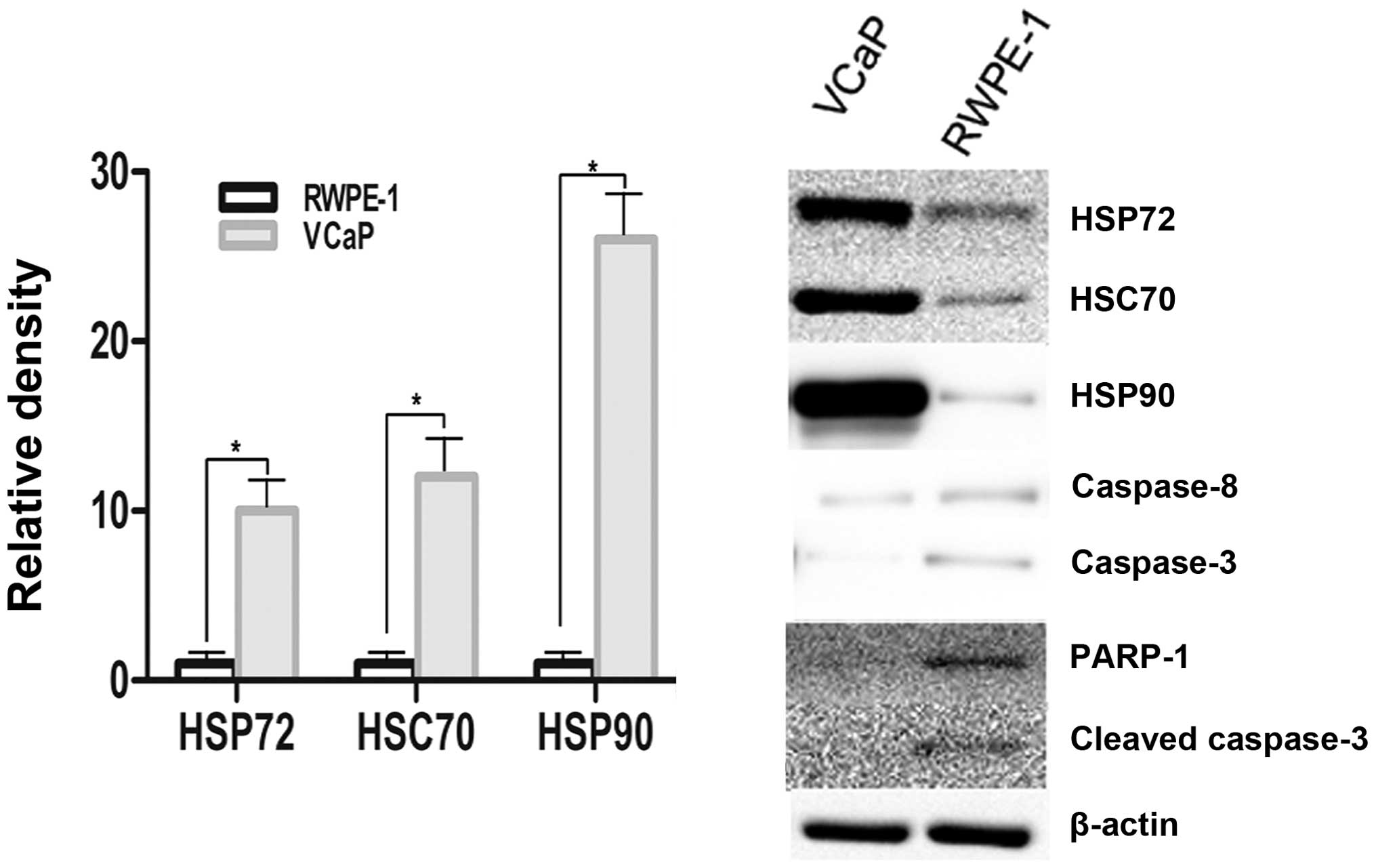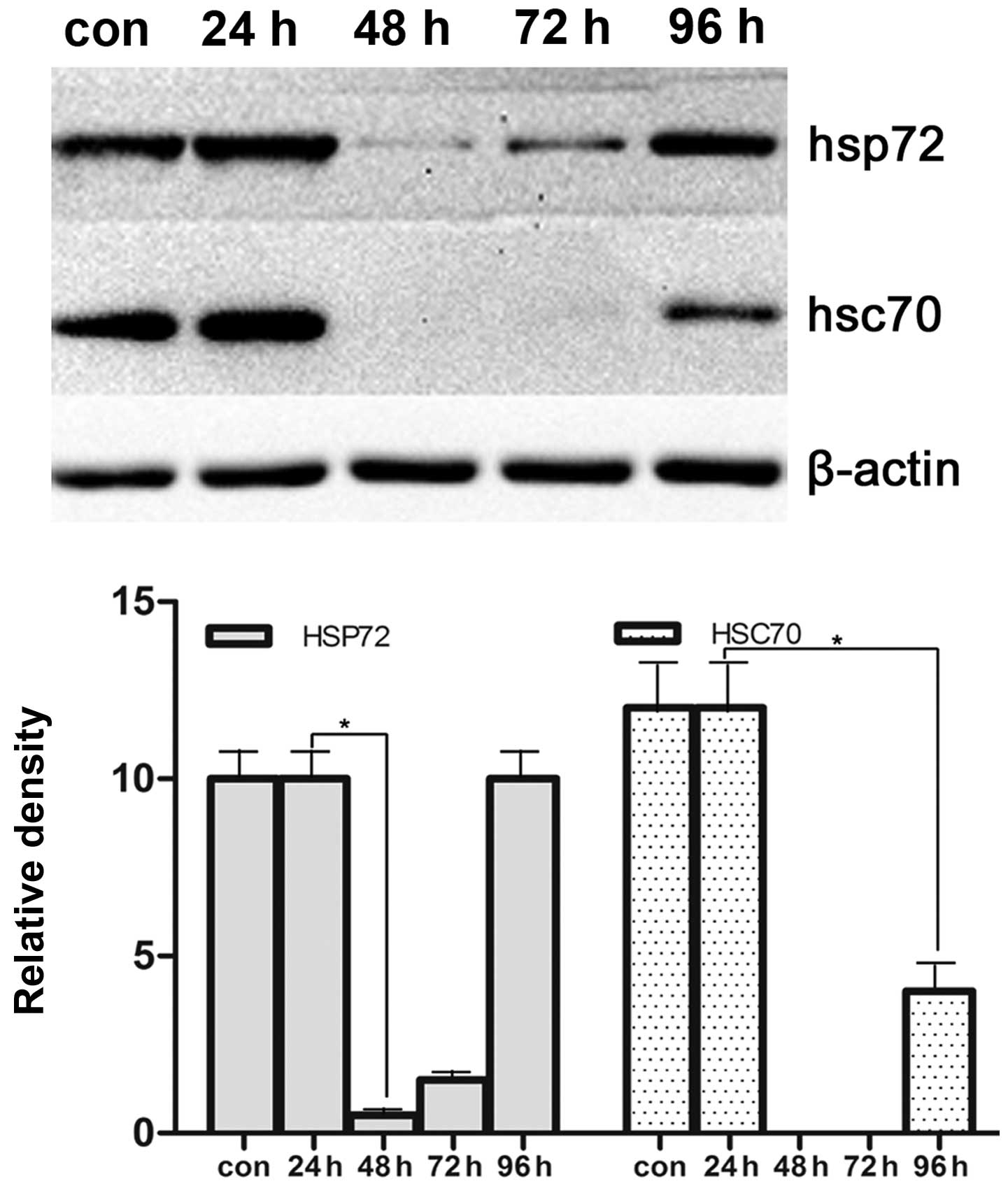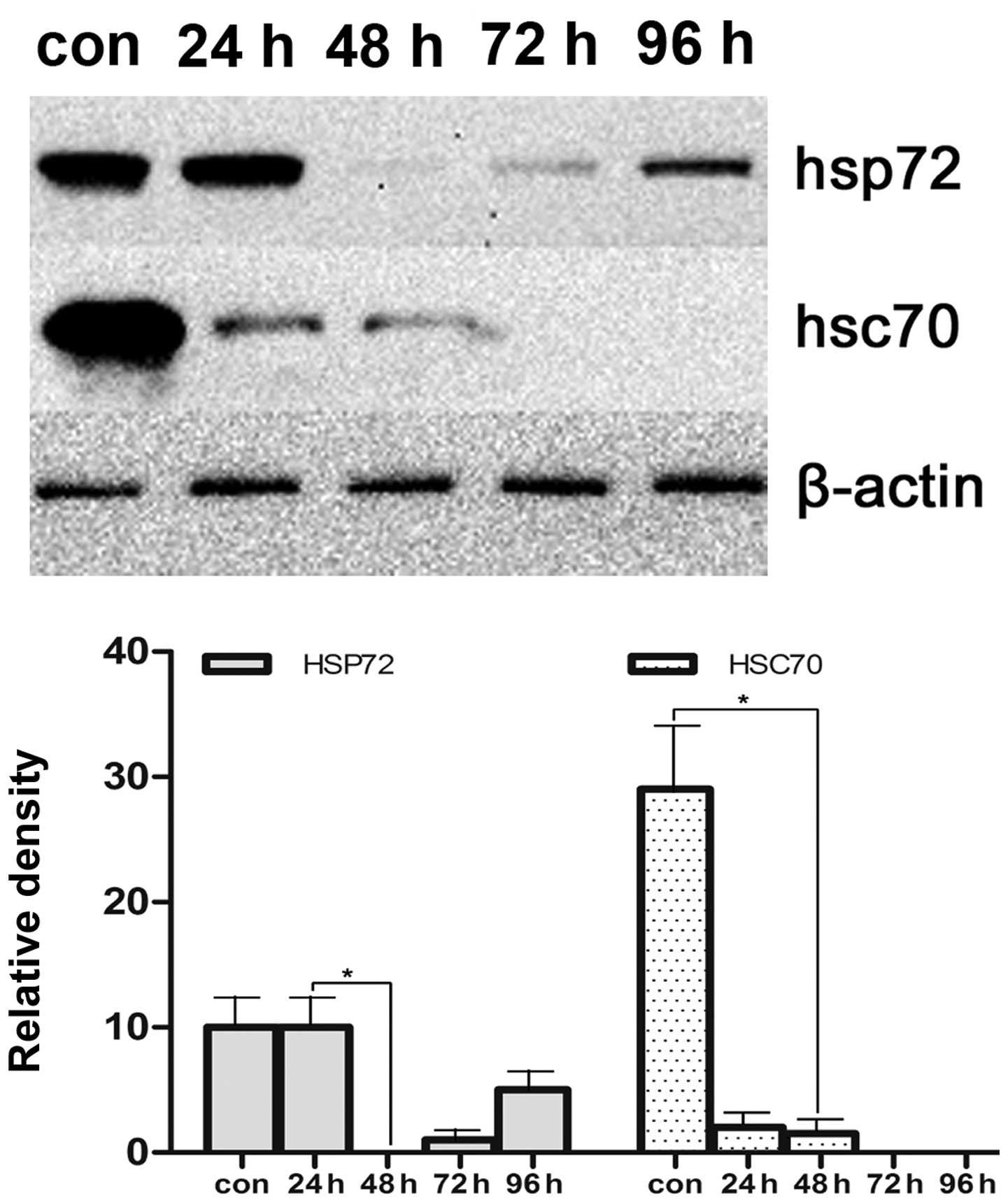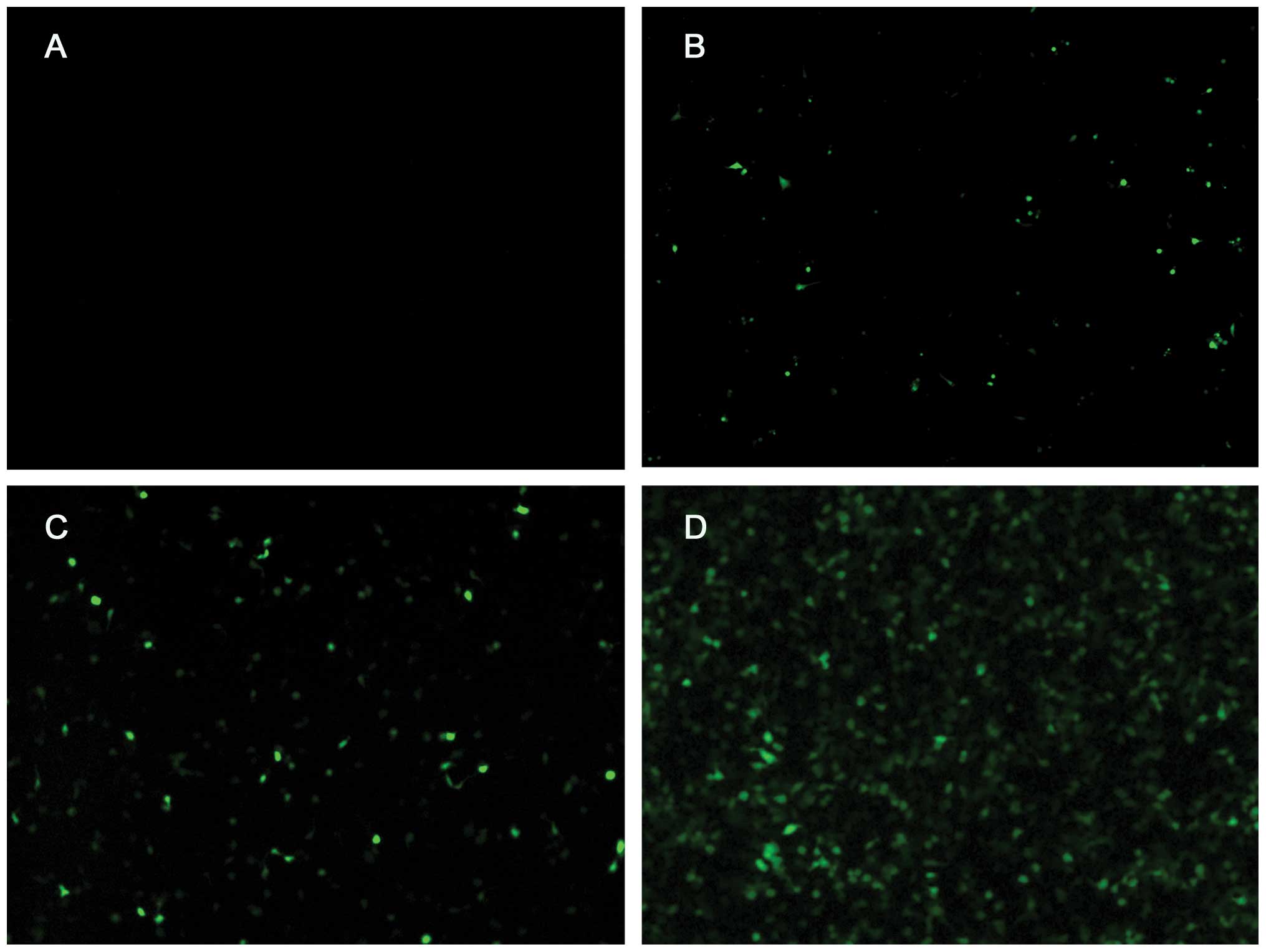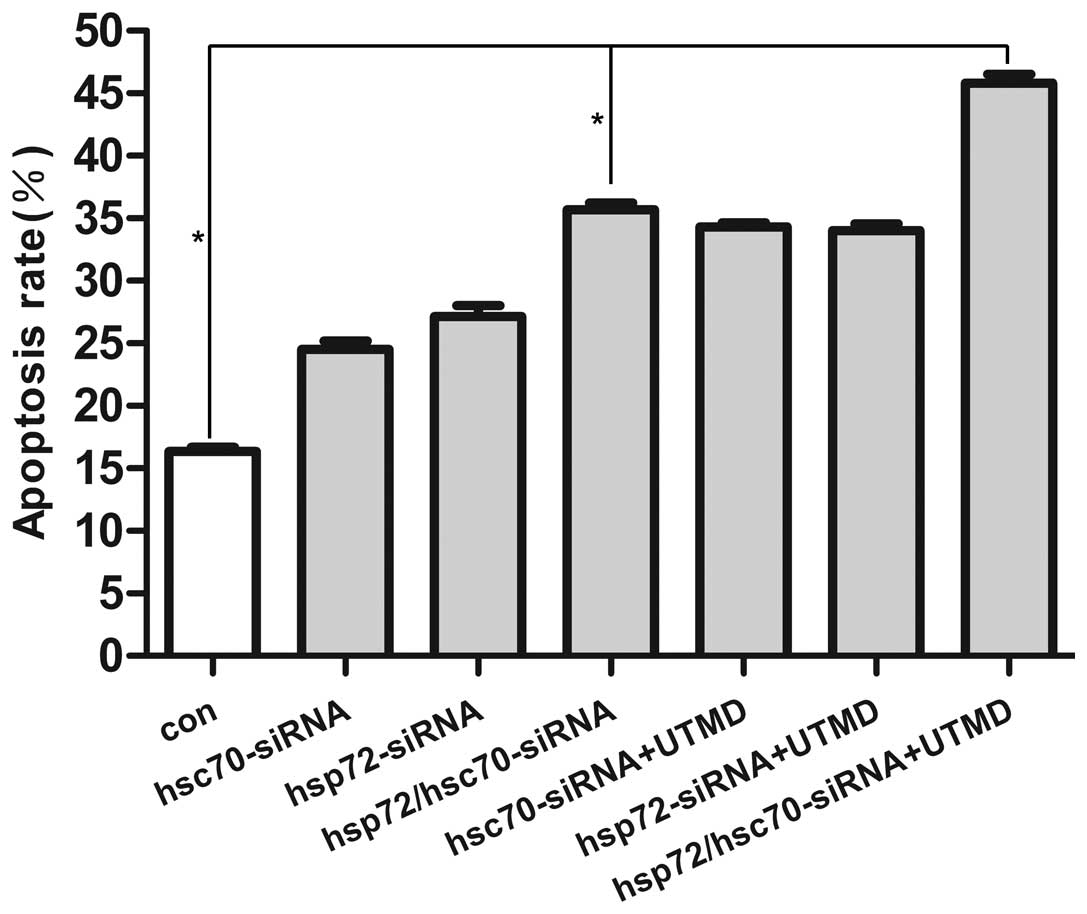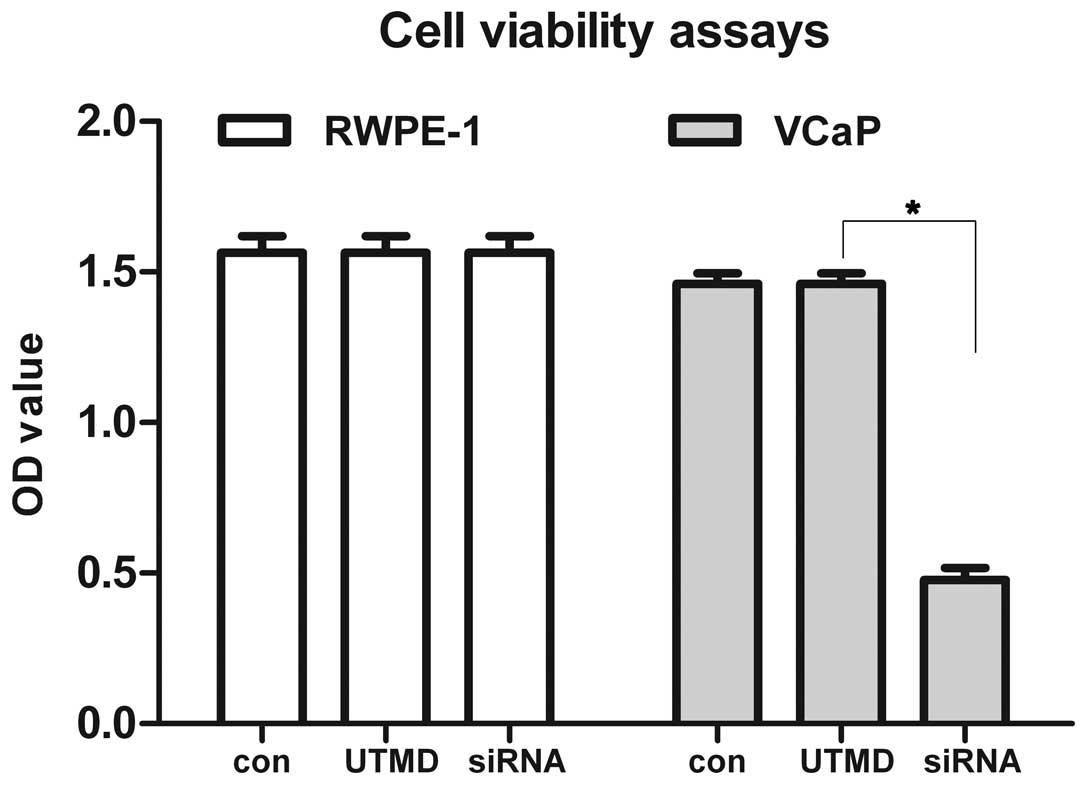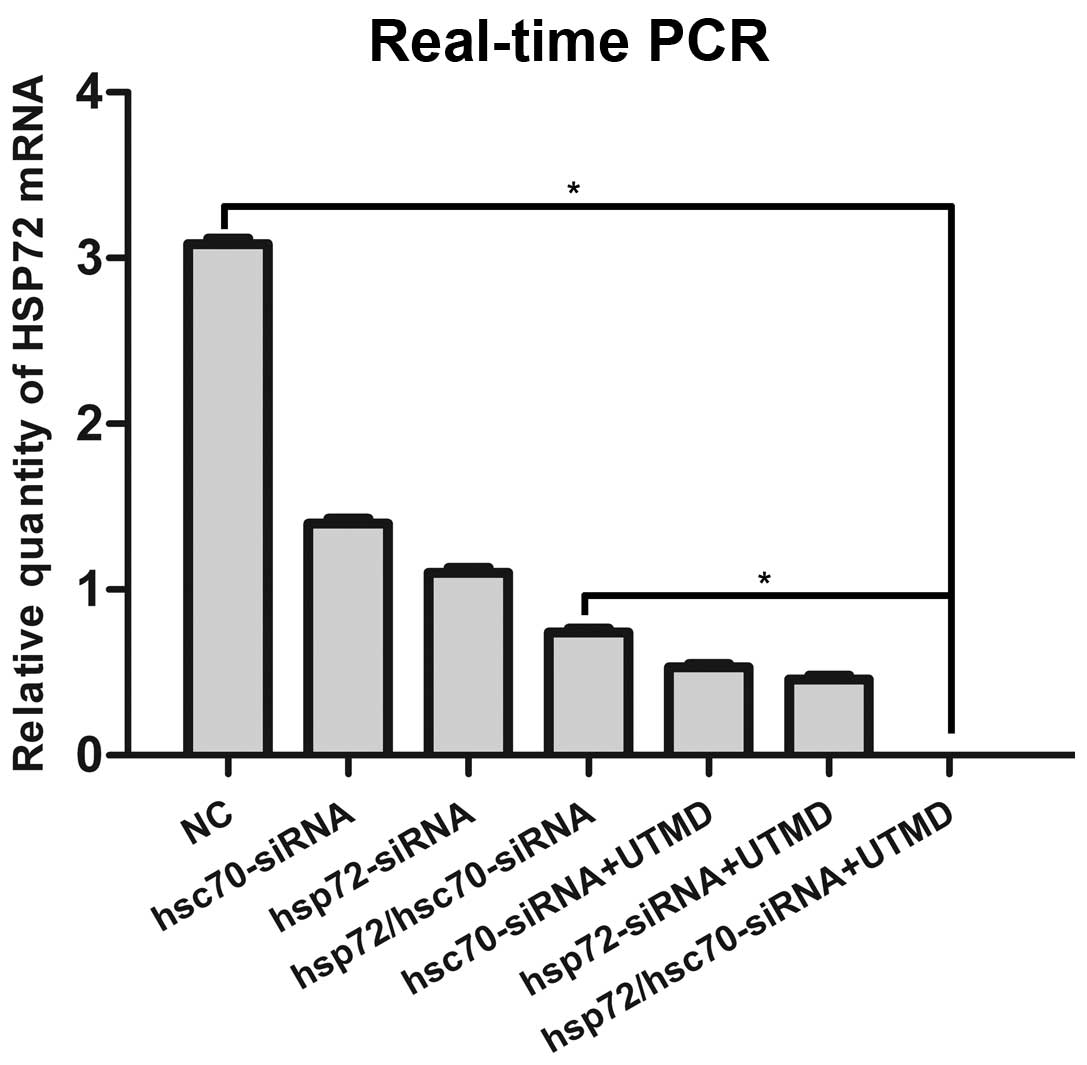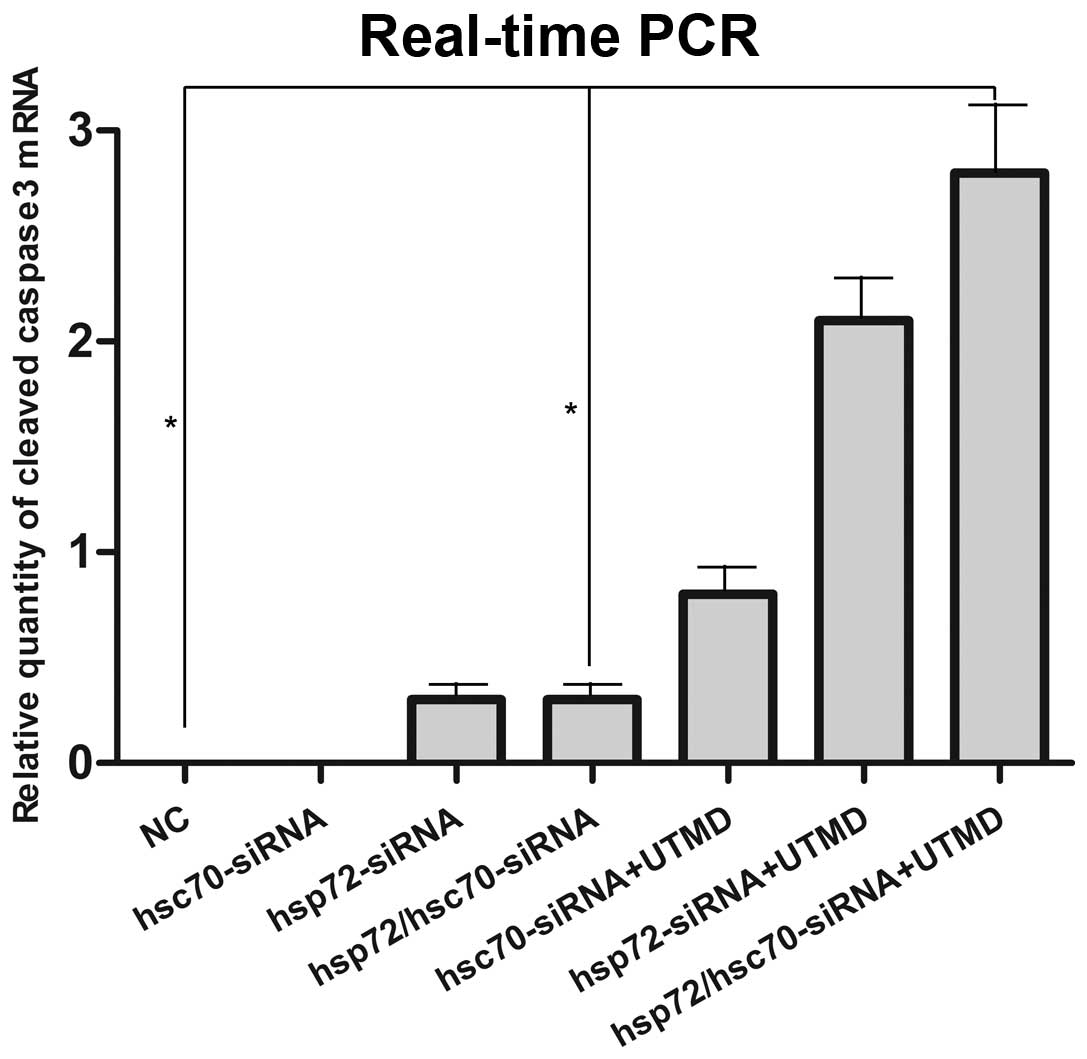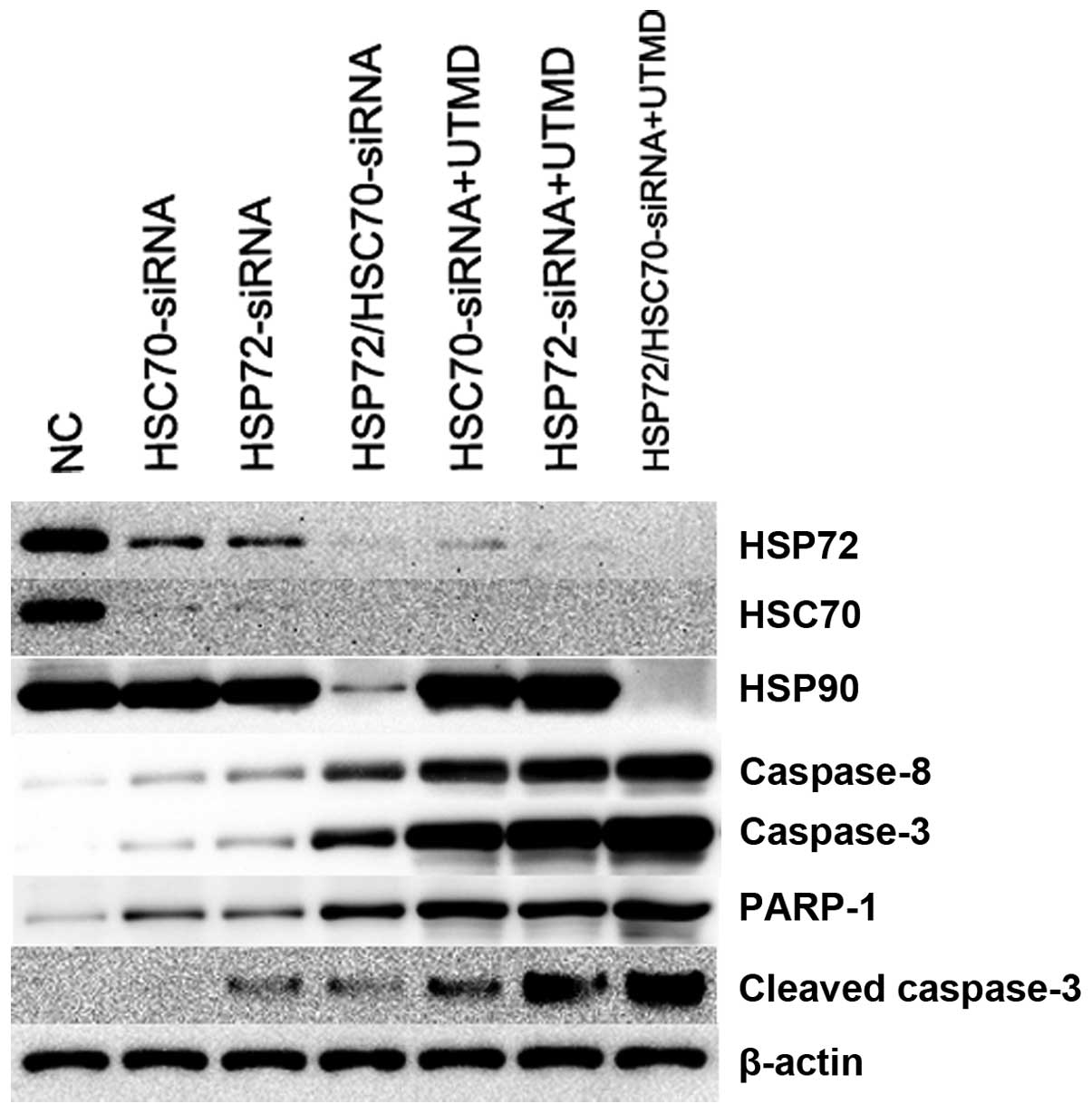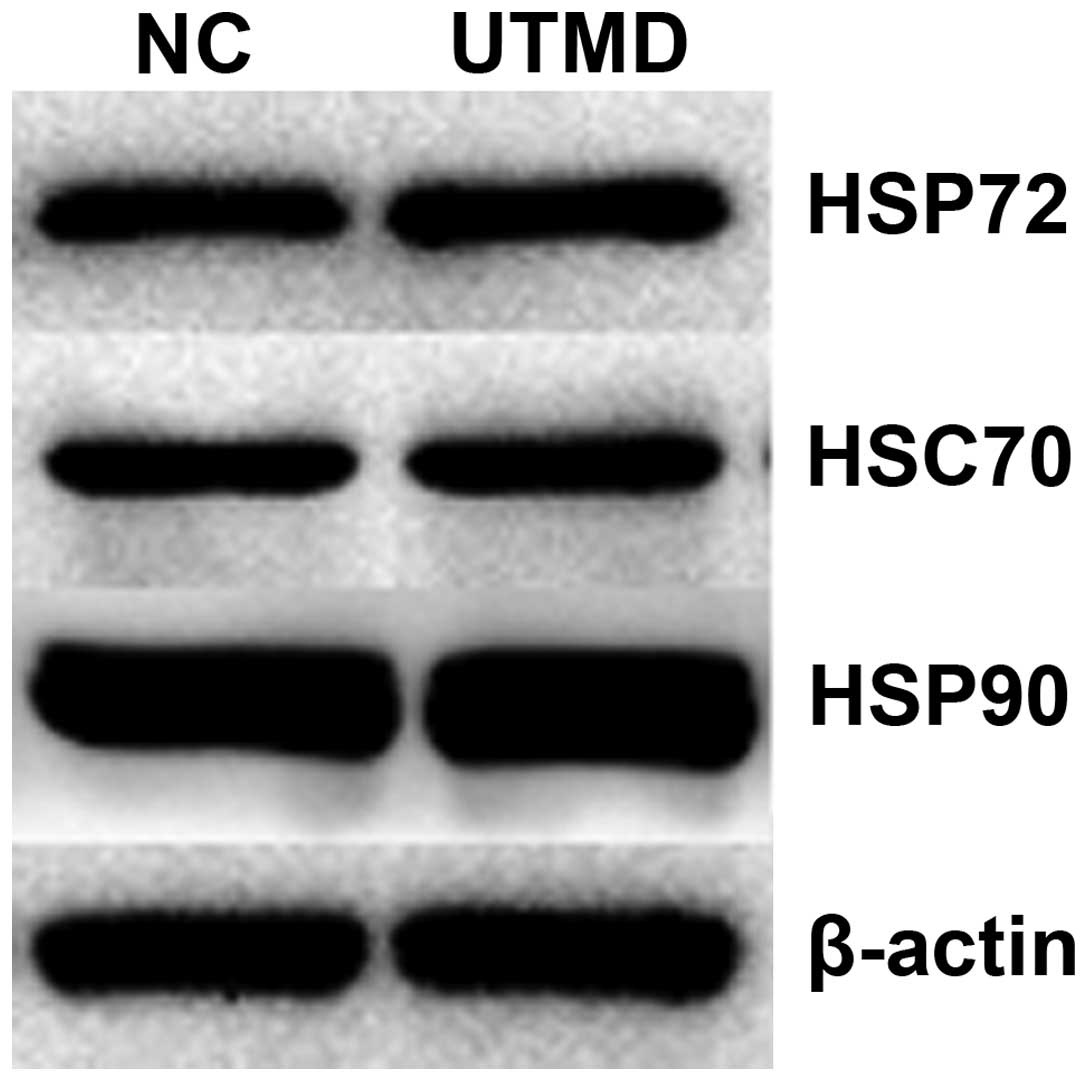Ultrasound-targeted microbubble destruction combined with dual targeting of HSP72 and HSC70 inhibits HSP90 function and induces extensive tumor-specific apoptosis
- Authors:
- Published online on: April 14, 2014 https://doi.org/10.3892/ijo.2014.2388
- Pages: 157-164
Abstract
Introduction
Prostate cancer (PCa) is the most frequent malignancy and a leading cause of cancer-related deaths in American men, accounting for an estimated 233,000 (27%) new cases and 29,480 (10%) deaths in 2014 (1–3). Androgen deprivation therapy (ADT) provides an effective therapy for patients with advanced PCa. Although most patients with advanced PCa show an initial response to ADT, a significant percentage of patients invariably progress to hormone refractory prostate cancer (HRPC) and castration-resistant prostate cancer (CRPC) (4,5). Effective targeting treatment for advanced CRPC and HRPC remains a critical clinical challenge. Thus, there is a clear need for novel targeted therapeutic strategies for the treatment of advanced PCa. siRNAs have provided us with clues how to tackle this issue. The properties of siRNA that are attractive for therapeutics include: i) stringent target-gene specificity, ii) relatively low immunogenicity of siRNA and iii) simplicity of design and testing of siRNA (6).
The HSP70 family includes at least eight members with diverse biochemical functions, including nascent protein folding, preventing denatured protein aggregation, and modulating assembly/disassembly of protein complexes (7,8). The exact role of the HSP70 family in cancer remains to be elucidated. Firstly, the two major cytoplasmic isoforms are HSC70 and HSP72. Generally, HSC70 is abundantly and ubiquitously expressed in nontumor tissues, whereas HSP72 is present at relatively low levels in the absence of stress. Secondly, HSC70 and HSP72 expression may reduce sensitivity to HSP90 inhibitors. HSP70 as a survival tool for cancer cells. Targets of HSP70 could be upstream and downstream of mitochondria. However, targeting HSP70 or androgen receptor alone can result in off-target effets, drug resistance and disease recurrence. Combinatorial modulation of these two HSP70 isoforms could therefore be doubly advantageous (9–15).
However, the specific and efficient delivery of siRNA into cancer cells in vivo remains a major obstacle (16). The scientific researchers try to develop a technique that employs UTMD to deliver genes to specific cells or tissues in a multi-model approach. Microbubble contrast agents are emerging nonviral vector systems capable of binding nucleic acids, and that may overcome some of the limitations of current siRNA delivery systems. The use of microbubbles as nucleic acid delivery vectors is based on the observation that the rupture of microbubbles via UTMD results in deposition of microbubble shell components and increased cell membrane permeability localized to the site of microbubble-ultrasound interaction. This phenomenon has been exploited to deliver drug and genes both in vitro and in vivo. We and others have recently shown that UTMD can deliver therapeutic genes to tumors (17–21).
In the present study, we sought to use UTMD to achieve RNAi as a strategy prostate cancer cells growth suppression. Specifically, we tested the hypothesis that UTMD-mediated delivery of dual targeting of HSC70 and HSP72 siRNA will inhibits HSP90 function, induce extensive tumor-specifc apoptosis.
Materials and methods
Cell and cell culture
The human prostate carcinoma cell line VCaP and prostate epithelial cell RWPE-1 cell line were obtained from American Type Culture Collection (ATCC, Manassas, VA) and cultured accordingly. VCaP cell lines were cultured in DMEM (Invitrogen) supplemented with 10% fetal bovine serum (Gibco), 100 U/ml penicillin and 100 U/ml streptomycin (Invitrogen) and maintained in a humidified atmosphere of 5% CO2, 95% air at 37°C. RWPE-1 cells were grown in Keratinocyte serum-free medium (K-SFM) medium (Invitrogen) supplemented with 5 ng/ml human recombinant EGF and 0.05 mg/ml bovine pituitary extract under standard cell culture conditions.
Experimental groups
VCaP cells were divided into the following 8 groups for gene transfection experiment. The control group (NC); HSP72 siRNA, HSC70-siRNA, HSP72/HSC70-siRNA; UTMD+HSP72-siRNA, UTMD+HSC70-siRNA, UTMD+HSP72/HSC70-siRNA; UTMD.
UTMD exposure protocols
A therapeutic ultrasound machine (Physioson-Basic, Physioson Elektromedizin, Germany) was used to emit ultrasound at the frequency of 1 MHz. The area of the ultrasound probe was 2.5 cm2. The ultrasound transducer was placed at the bottom of plates or dishes with coupling medium on the surface of the transducer. The adjustable sonication parameters included ultrasound intensity, exposure time, pulse frequency, and duty cycle.
Microbubbles (SonoVue, Bracco, Milan, Italy) were lipid-shelled ultrasound contrast agents containing sulfur hexafluoride gas (diameter 2.5–6.0 μm) and used at a concentration of ∼2×108 bubbles/ml. The volumetric ratio of microbubbles to medium dictated the choice of contrast agent dose.
After protocol optimization with several various settings, the following UTMD parameters were used: ultrasound intensity, 1 W/cm2; exposure time, 60 sec; pulse frequency, 100 Hz; duty cycle, 20%; volumetric ratio of microbubbles: medium, 1:5.
siRNA-mediated gene knockdown
siRNAs (Shanghai GenePharma Co., Ltd.) were designed against the open reading frame of HSP72 (HSPA1A; accession number NM_005345) or HSC70 (HSPA8; accession number NM_006597). Two active sequences were used for studies against HSP72 or HSC70 (designated HSP72 or HSC70). Active sequences for HSP72 and HSC70 are as follows: HSP72 (sense: GGACGAGUUUG AGCACAAGTT, antisense: CUUGUGCUCAAACUCGUC CTT), HSC70 (sense: CCAAGCAGACGCAGAUCUUTT, antisense: AAGAUCUGCGUCUGCUUGGTT), Negative control (sense: UUCUCCGAACGUGUCACGUTT, antisense: ACGUGACACGUUCGGAGAATT). For all experiments cells were transfected with siRNA (200 nM for single transfections or 100 nM for combinatorial transfections) in Opti-MEM® medium without serum according to the Lipofectamine® 2000 protocol (Invitrogen). An equal amount of scrambled Stealth siRNA was used as a negative control. Six hours after the cells were transfected, the medium was replaced with fresh culture medium. All experiments were performed 48 h after transfection and repeated three times.
Gene transfection efficiency
Following gene transfection, the effciency of transfection was evaluated by fuorescence microscopy and flow cytometry. Green fuorescence was detected using inverted fuorescence microscopy (Zeiss Axiovert S100; Carl Zeiss, Jena, Germany). The percentage of FAM expression of the transducted VCaP cells was quantitatively measured by flow cytometry (FACSCalibur; BD Biosciences, Franklin Lakes, NJ, USA).
Cell viability assays
A Cell Counting Kit-8 assay (CCK-8, Dojindo Laboratories) was used to evaluate relative cell viability. At 48 h after siRNA transfections, RWPE-1 and VCaP cells were plated in 96-well microtiter plates at a density of 5×103 cells per well, then the live cell count was assayed using CCK-8 according to the manufacturer’s instructions. Briefly, 10 μl of CCK8 solution was added to each well, and the absorbance at 450 nm was measured using a Thermomax microplate reader (Molecular Devices, Hercules, CA, USA) after 1–4 h of incubation. Relative cell viability was calculated as a percentage of untreated control cells.
Flow cytometry
Cells were trypsinized and resuspended in Opti-MEM medium and plated on 6-well plates at 1,000 cells/well after transfection with siRNA for 48 h. For apoptosis detection, cells were stained with Annexin V and propidium iodide using the Annexin V-FITC Apoptosis Detection kit (Invitrogen), and the percentage of apoptotic cells was determined by flow cytometry (Beckman Coulter).
Quantitative real-time PCR
Total RNA from cultured cells was extracted using TRIzol reagent (Invitrogen) and reverse transcription was performed by PrimeScript® RT Master mix Perfect real-time (Takara) according to the manufacturer’s instructions. RNA integrity was examined by agarose gel electrophoresis. Quantitative RT-PCR was performed in triplicate using the SYBR-Green (Takara) method on an Applied Biosystems Fast Sequence Detector System. Conditions for each target were validated by standard and melting curve analyses. We used β-actin expression as an internal control. Expression was normalized to β-actin and determined using the Applied Biosystems 7500. All primers were designed using Primer 5 and synthesized by Shanghai Sunny Biotechnology Co., Ltd. The following primers were used: HSP72 (forward, 5′-TGGAGTCCTACGCCTTCAAC-3′ reverse, 5′-AGCCAC GAGATGACCTCTTG-3′), HSC70 (forward, 5′-CGCAAGC ATAAGAAGGACATCA-3′ reverse, 5′-GAACAGGTCAGC ATTCAGTTCT-3′), β-actin (forward, 5′-GGAGATTACTGC CCTGGCTCCTA-3′ reverse, 5′-GACTCATCGTACTCCT GCTTGCTG-3′). Caspase-3 (forward, 5′-GAACTGGACTG TGGCATTGAGA-3′ reverse, 5′-ATGGCACAAAGCGAC TGGATGA-3′). HSP90 (forward, 5′-TCTTGGCACCACCT ACTCTTGT-3′ reverse, 5′-CATCACCGATCAACCGT TCAGT-3′).
Western blot analysis
Prostate cells transfected with siRNA were washed twice in ice-cold phosphate buffer solution (PBS), harvested and then lysed using RIPA buffer (Sigma). Protein concentrations were quantified using the BCA Protein assay kit (Thermo Scientific, Rockford, IL, USA). Equal amounts of protein and PageRuler™ Prestained molecular weight markers (Thermo Scientific) were separated by 8% or 10% SDS-PAGE and transferred to 0.45 μm pore size PVDF membrane (Millipore). Membranes were blocked in TBS with Tween-20 containing 5% skim milk (Bright Dairy) and incubated with the primary antibody at room temperature for 1 h in blocking buffer. Antibodies and dilutions were 1:2,000 for anti-HSP72 (C92F3A-5, Stressgen Biotech Corp.), 1:1,000 for anti-caspase-8 (1006-1, Epitomics), 1:2,000 for anti-HSP90 (2877-1, Epitomics), 1:50,000 for anti-PARP-1 (1051-1, Epitomics), 1:5,000 for anti-HSC70, anti-caspase-3 (1776-1, 1087-1, Epitomics), 1:2,000 for anti-cleaved caspase-3, and anti-β-actin (9664, 4970, Cell Signaling Technology) antibodies. Washing steps after hybridization were three times at room temperature for 10 min for all other antibodies. Membranes were incubated with secondary HRP-conjugated antibodies diluted 1:2,000 in blocking buffer and at room temperature for 1 h. After three washing steps of 10 min at room temperature, detection of the signals was performed using the Immobilon Western Chemiluminescent HRP Substrate (Millipore).
Statistical analysis
Statistical analysis was carried out with SPSS version 12.0 (SPSS, Inc., Chicago, IL, USA). All data are presented as mean ± SD and analyzed by One-way ANOVA. Values were considered statistically significant at P<0.05. Results are representative of more than three individual experiments.
Results
HSP72, HSC70 and HSP90 is overexpressed in human prostate cancer cells compared with human prostate epithelial cells
HSP70 is a critical co-chaperone for HSP90. HSP70 and HSP90 are important therapeutic biomarker of prostate cancer. Caspase-8 is a member of a family of cysteine-requiring aspar-tate proteases that participate in the intracellular signaling cascade leading to apoptosis (programmed cell death) (22). Poly (ADP-ribose) polymerase (PARP) is zinc-dependent DNA binding protein that recognizes DNA strand breaks and is presumed to play a role in DNA repair. As a marker for apoptosis, PARP is cleaved in vitro by many caspases (23). We detected the cleaved caspase-8 and p25 cleaved-form of PARP-1 (Cleaved p25). We compared gene expression profiles of VCaP and RWPE-1 in vitro, and found that HSP72, HSC70, and HSP90 was overexpressed in VCaP cells. Western blot analysis revealed that VCaP cells expressed higher levels of HSP72, HSC70 and HSP90 protein in vitro compared with RWPE-1, which expressed undetectable levels. VCaP and RWPE-1 cells expressed very low levels of caspase-8, caspase-3, PARP-1 and cleaved caspase-3 (Fig. 1).
Effects of HSP70 expression after transfection at different time points
To confirm the optimal time points in HSP70 expression in vitro after transfection, we selected 24, 48, 72, 96 h to quantify the expression of HSP70 protein in VCaP cells. As shown in Figs. 2 and 3, optimal time points of efficacy of silencing HSP70 gene by siRNA is 48 h. Therefore, this was used for further investigation after transfection in vitro.
Gene transfection efficiency and apoptosis
Fig. 4 shows the UTMD+HSC70/HSP72-siRNA group had maximal transfection percentage (73.15±0.53) and it was significantly higher than HSC70/HSP72-siRNA group (40.37±0.65), UTMD+HSC70-siRNA group (28.31±0.60) and UTMD+HSP72-siRNA group (24.25±0.53). In accordance with the results of transfection analysis, the apoptosis percentage of the UTMD+HSC70/HSP72-siRNA group was the highest (47.16%) and the other 6 groups had significant difference between each other (P<0.05). It seems that the UTMD+HSC70/HSP72-siRNA could serve as a gene delivery system, and silencing HSP70 and HSP90 expression induced extensive cell apoptosis (Fig. 5).
UTMD is a safe and noninvasive approach
In order to investigate the safety of UTMD, cellular viability was monitored using the Cell Counting Kit-8 assay for 48 h. The cellular viability of VCaP cells transfected with HSP72 and HSC70 siRNA was delayed compared with that of the control groups after UTMD. No significant difference was found in the cellular viability between the RWPE-1 and VCaP of the control group and the two group treated with UTMD (Fig. 6).
To investigate the molecular mechanisms by which the combination of UTMD and HSP70-siRNA restrains PCa in the context of HRPC, we processed a set of relevant experiment in vitro. RT-qPCR revealed 3.1-fold higher levels of HSP72, HSC70 and HSP90 mRNA in NC control compared with HSP72/HSC70-siRNA treatment (Figs. 7-Figs. 10). The group of UTMD combined with HSP72/HSC70-siRNA expressed undetectable levels of HSP72, HSC70 and HSP90 mRNA. This is consistent with the results of western blotting in VCaP cells (Figs. 11 and 12). To better understand the biological processes that underlie what appears to be HSP70, HSP90, and cleaved caspase-3 in VCaP cells, we next sought to define the mechanism by which HSP70 regulates cleaved caspase-3 expression. We found that the caspase-3, caspase-8, PARP-1, and cleaved caspase-3 gene was the most significantly enriched in the group of UTMD combined HSP72/HSC70-siRNA (Figs. 10 and 11). Therefore, we tested the ability of the combination of UTMD with HSP72/HSC70-siRNA to induce tumor specific apoptosis.
Discussion
Silencing of gene expression by siRNA is rapidly becoming a powerful tool against cancer, efficient delivery of siRNA into tumor cells remains a key obstacle (24). Although local surgery, radiation, or hormonal ablation provide initial response at earlystages of the disease, tumor cells often develop resistance and relapse. Thus, the identification of new therapeutic targets for prostate cancer is of critical importance. Recent studies further revealed that ≈2/3 of human prostate cancers expressed high level of HSP72 and HSC70, associating with recurrence, development of castration-resistance, and poor survival (25,26). These studies provide the first hints that HSP72 and HSC70 may have a critical role in prostate cancer development and therapeutic resistance. HSP90 is an exciting therapeutic target in cancer because inhibition of this single protein causes the simultaneous degradation of multiple oncoproteins and combinatorial blockade of numerous oncogenic pathways. HSP70 molecular chaperones are of interest when considering modulation of HSP90 (27). HSP70 is the major therapeutic target in advanced PCa (28–32). However, targeting HSP70 or androgen receptor alone can result in off-target effects, drug resistance and disease recurrence (30,33,34). Therefore, simultaneous targeting of a multi-modal approach or multiple pathways in targeted delivery could in principle be an effective approach to treating prostate cancer. With respect to the functional role of HSP70 isoforms in the HSP90 chaperone, the data we presented here demonstrate that silencing HSC70 or HSP72 individually has little effect on HSC70 and HSP72, has no effect on HSP90 protein level of VCaP prostate cancer cells, while dual targeting of HSC70 and HSP72 inhibit the cellular chaperone activity of HSP90, and has good silencing effect on HSC70 and HSP72, thus induce tumor-specifc apoptosis. Additionally, UTMD combined with simultaneous targeting of HSC70 and HSP72 may further enhance silencing efficacy of the expression of HSP72, HSC70, HSP90 protein and mRNA. In agreement with our findings, Powers et al (34) also found that dual targeting of HSC70 and HSP72 silence HSP90 protein and induce extensive tumor-specifc apoptosis in human HCT116 colon and A2780 ovarian cells.
In the present study, we have shown by flow cytometry that silencing HSC70 or HSP72 individually has no effect on apoptosis. Using combinatorial siRNA approach, we revealed that dual silencing of HSC70 and HSP72 considerably increased the apoptotic efficacy by 20% compare with control group, UTMD may further enhance extensive tumor-specific apoptosis by 11% (Fig. 5). Our apoptosis results were in accord with the study of Rérole et al (35). In order to confirm further the results of flow cytometry, we selected several major apoptotic markers. Caspase-3, caspase-8, PARP-1 and cleaved caspase-3 are the main executor of apoptosis and considered to be key hallmarks of apoptosis (36,37). Our data on apoptosis is in near agreement with the expression of major apoptotic markers (caspase-8, caspase-3, PARP-1, cleaved caspase-3) of western blotting. Of note, the safety and noninvasiveness of the combinational targeting strengthen our confidence further. UTMD is a noninvasive physical gene delivery technology by sonoporation. There is no significant difference of cell viability in the UTMD group and normal control group, indicating that UTMD cells without any apparent toxicity, but also UTMD can promote effective uptake of siRNA, and enhance the specificity of siRNA to silence HSP70 and HSP90. Therefore, we may promote the efficacy and specificity of siRNA delivered by UTMD. UTMD may improve the accuracy of target genes. Moreover, these data indicate that this is a promising strategy for inducing tumor-specific apoptosis in vitro. The safety of the combinational targeting in vivo need to be explored in subsequent experiments.
The most important attribute of UTMD combination with siRNA is their specific, efficient delivery, which leads to concentration in the target tumor and avoidance of distribution to irrelevant normal tissues. Specific delivery into the intended target cells will likely reduce the dose required for antitumor activity as well as limit toxicity.
An exciting implication of our research is the attractiveness of combinatorial targeting of HSC70 and HSP72 as an alternative means to achieve HSP90 inhibition, with the added advantage of avoiding the anti-apoptotic effects of HSP70 isoform induction that limit the use of current pharmacologic inhibitors. Noteworthy, UTMD may promote the effect of silencing HSP90. The approach of UTMD combined siRNA was used here as a tool to silence the expression of HSC70, HSP72 and HSP90. It is possible that UTMD combined with RNA interference may be developed as a potential therapeutic approach.
Our findings also revealed further details about the relationship between UTMD and siRNA, especially in the context of HRPC. The reasons why UTMD combined with dual targeting of HSC70 and HSP72 improve the efficacy of silencing are: Firstly, UTMD promote the efficient delivery and cell uptake of siRNA. Secondly, UTMD also may activate the active region of HSP72, HSC70, HSP90 or increase crosstalk between distinct signaling pathways. Thirdly, UTMD combined with dual targeting of siRNA might active multiple signal transduction pathways of apoptosis and heat shock protein. Fourthly, UTMD improve the permeability and ATP energy of mitochondria. Further work is required to identify the molecular and cellular mechanisms whereby UTMD promote dual targeting of siRNA induce extensive tumor-specifc apoptosis in vitro and in vivo from the results presented here.
In conclusion, UTMD-mediated delivery of dual targeting of siRNA is a promising strategy for treatment of prostate cancer in vitro that could prove more effective and specific than other siRNA delivery strategies. The other main finding of this study is the potential superiority for HSP70 and HSP90 as biomarker targeting in PCa (33,38). Our data establish that UTMD-directed simultaneous targeting of siRNA therapeutics is minimally invasive, and effective at suppressing tumor growth, and induce extensive tumor-specifc apoptosis, and these data might provide insights into further optimization and the multi-model delivery strategy is versatile in specific gene silencing of targeted therapeutics of cancer.
Abbreviations:
|
UTMD |
ultrasound-targeted microbubble destruction; |
|
siRNA |
small interfering RNA; |
|
HRPC |
hormone refractory prostate cancer; |
|
RT-PCR |
reverse transcriptase-polymerase chain reaction |
Acknowledgements
We thank members of the Guo Hui Fu Laboratory for helpful discussions. We thank Dr J.J. Yu for technical assistance. This study was supported by the National Natural Science Foundation of China; grant no. 81171352 and 81271596 (to L. Du), no. 81201097 (to M. Bai), and the Natural Science Foundation of Shanghai no. 12ZR1424800 (to M. Bai) is gratefully acknowledged.
References
|
Siegel R, Ma J, Zou Z, et al: Cancer statistics, 2014. CA Cancer J Clin. 64:9–29. 2014. View Article : Google Scholar | |
|
DeSantis C, Naishadham D and Jemal A: Cancer statistics for African Americans, 2013. CA Cancer J Clin. 63:151–166. 2013. View Article : Google Scholar : PubMed/NCBI | |
|
Jemal A, Bray F, Center MM, et al: Global cancer statistics. CA Cancer J Clin. 61:69–90. 2011. View Article : Google Scholar | |
|
Bitting RL and Armstrong AJ: Targeting the PI3K/Akt/mTOR pathway in castration-resistant prostate cancer. Endocr Relat Cancer. 20:R83–R99. 2013. View Article : Google Scholar : PubMed/NCBI | |
|
Garcia JA and Rini BI: Castration-resistant prostate cancer: Many treatments, many options, many challenges ahead. Cancer. 118:2583–2593. 2012. View Article : Google Scholar : PubMed/NCBI | |
|
McNamara JO II, Andrechek ER, Wang Y, et al: Cell type-specific delivery of siRNAs with aptamer-siRNA chimeras. Nat Biotechnol. 24:1005–1015. 2006. View Article : Google Scholar : PubMed/NCBI | |
|
Daugaard M, Rohde M and Jäättelä M: The heat shock protein 70 family: highly homologous proteins with overlapping and distinct functions. FEBS Lett. 581:3702–3710. 2007. View Article : Google Scholar : PubMed/NCBI | |
|
Zuiderweg ER, Bertelsen EB, Rousaki A, et al: Allostery in the Hsp70 chaperone proteins. Top Curr Chem. 328:99–153. 2013. View Article : Google Scholar : PubMed/NCBI | |
|
Davenport EL, Zeisig A, Aronson LI, et al: Targeting heat shock protein 72 enhances Hsp90 inhibitor-induced apoptosis in myeloma. Leukemia. 24:1804–1807. 2010. View Article : Google Scholar : PubMed/NCBI | |
|
Powers MV, Jones K, Barillari C, et al: Targeting HSP70: the second potentially druggable heat shock protein and molecular chaperone? Cell Cycle. 9:1542–1550. 2010. View Article : Google Scholar : PubMed/NCBI | |
|
Meng L, Hunt C, Yaglom JA, et al: Heat shock protein Hsp72 plays role in Her2-induced mammary tumorigenesis. Oncogene. 30:2836–2845. 2011. View Article : Google Scholar : PubMed/NCBI | |
|
Stangl S, Gehrmann M, Riegger J, et al: Targeting membrane heat-shock protein 70 (Hsp70) on tumors by cmHsp70.1 antibody. Proc Natl Acad Sci USA. 108:733–738. 2011. View Article : Google Scholar : PubMed/NCBI | |
|
Evans CG, Chang L and Gestwicki JE: Heat shock protein 70 (hsp70) as an emerging drug target. J Med Chem. 53:4585–4602. 2010. View Article : Google Scholar : PubMed/NCBI | |
|
Balaburski GM, Leu JI, Beeharry N, et al: A modified HSP70 inhibitor shows broad activity as an anticancer agent. Mol Cancer Res. 11:219–229. 2013. View Article : Google Scholar : PubMed/NCBI | |
|
Rérole AL, Gobbo J, De Thonel A, et al: Peptides and aptamers targeting HSP70: a novel approach for anticancer chemotherapy. Cancer Res. 71:484–495. 2011. | |
|
Yao YD, Sun TM, Huang SY, et al: Targeted delivery of PLK1-siRNA by ScFv suppresses HER2+ breast cancer growth and metastasis. Sci Transl Med. 4:130ra482012.PubMed/NCBI | |
|
Li HL, Zheng XZ, Wang HP, et al: Ultrasound-targeted micro-bubble destruction enhances AAV-mediated gene transfection in human RPE cells in vitro and rat retina in vivo. Gene Ther. 16:1146–1153. 2009. View Article : Google Scholar : PubMed/NCBI | |
|
Xie W, Liu S, Su H, et al: Ultrasound microbubbles enhance recombinant adeno-associated virus vector delivery to retinal ganglion cells in vivo. Acad Radiol. 17:1242–1248. 2010. View Article : Google Scholar : PubMed/NCBI | |
|
Zheng X, Du L, Wang H and Gu Q: A novel approach to attenuate proliferative vitreoretinopathy using ultrasound-targeted microbubble destruction and recombinant adeno-associated virus-mediated RNA interference targeting transforming growth factor-β2 and platelet-derived growth factor-B. J Gene Med. 14:339–347. 2012.PubMed/NCBI | |
|
Suzuki R, Oda Y, Utoguchi N and Maruyama K: Progress in the development of ultrasound-mediated gene delivery systems utilizing nano- and microbubbles. J Control Release. 149:36–41. 2011. View Article : Google Scholar : PubMed/NCBI | |
|
Tachibana K, Uchida T, Ogawa K, et al: Induction of cell-membrane porosity by ultrasound. Lancet. 353:14091999. View Article : Google Scholar : PubMed/NCBI | |
|
Boldin MP, Goncharov TM, Goltsev YV and Wallach D: Involvement of MACH, a novel MORT1/FADD-interacting protease, in Fas/APO-1- and TNF receptor-induced cell death. Cell. 85:803–815. 1996. View Article : Google Scholar : PubMed/NCBI | |
|
Lazebnik YA, Kaufmann SH, Desnoyers S, et al: Cleavage of poly(ADP-ribose) polymerase by a proteinase with properties like ICE. Nature. 371:346–347. 1994. View Article : Google Scholar : PubMed/NCBI | |
|
Pai SI, Lin YY, Macaes B, et al: Prospects of RNA interference therapy for cancer. Gene Ther. 13:464–477. 2006. View Article : Google Scholar : PubMed/NCBI | |
|
Daneshmand S, Quek ML, Lin E, et al: Glucose-regulated protein GRP78 is up-regulated in prostate cancer and correlates with recurrence and survival. Hum Pathol. 38:1547–1552. 2007. View Article : Google Scholar : PubMed/NCBI | |
|
Pootrakul L, Datar RH, Shi SR, et al: Expression of stress response protein Grp78 is associated with the development of castration-resistant prostate cancer. Clin Cancer Res. 12:5987–5993. 2006. View Article : Google Scholar : PubMed/NCBI | |
|
Whitesell L and Lindquist SL: HSP90 and the chaperoning of cancer. Nat Rev Cancer. 5:761–772. 2005. View Article : Google Scholar : PubMed/NCBI | |
|
Lebret T, Watson RW and Fitzpatrick JM: Heat shock proteins: their role in urological tumors. J Urol. 169:338–346. 2003. View Article : Google Scholar : PubMed/NCBI | |
|
Garrido C, Schmitt E, Candé C, et al: HSP27 and HSP70: potentially oncogenic apoptosis inhibitors. Cell Cycle. 2:579–584. 2003. View Article : Google Scholar | |
|
McConnell JR and McAlpine SR: Heat shock proteins 27, 40, and 70 as combinational and dual therapeutic cancer targets. Bioorg Med Chem Lett. 23:1923–1928. 2013. View Article : Google Scholar : PubMed/NCBI | |
|
Alaiya AA, Oppermann M, Langridge J, et al: Identification of proteins in human prostate tumor material by two-dimensional gel electrophoresis and mass spectrometry. Cell Mol Life Sci. 58:307–311. 2001. View Article : Google Scholar : PubMed/NCBI | |
|
Mayer MP: Hsp70 chaperone dynamics and molecular mechanism. Trends Biochem Sci. 38:507–514. 2013. View Article : Google Scholar : PubMed/NCBI | |
|
Lee E, Madar A, David G, et al: Inhibition of androgen receptor and β-catenin activity in prostate cancer. Proc Natl Acad Sci USA. 110:15710–15715. 2013. | |
|
Powers MV, Clarke PA and Workman P: Dual targeting of HSC70 and HSP72 inhibits HSP90 function and induces tumor-specific apoptosis. Cancer Cell. 14:250–262. 2008. View Article : Google Scholar : PubMed/NCBI | |
|
Rérole AL, Jego G and Garrido C: Hsp70: anti-apoptotic and tumorigenic protein. Methods Mol Biol. 787:205–230. 2011. | |
|
Earnshaw WC, Martins LM and Kaufmann SH: Mammalian caspases: structure, activation, substrates, and functions during apoptosis. Annu Rev Biochem. 68:383–424. 1999. View Article : Google Scholar : PubMed/NCBI | |
|
Tang NY, Huang YT, Yu CS, et al: Phenethyl isothiocyanate (PEITC) promotes G2/M phase arrest via p53 expression and induces apoptosis through caspase- and mitochondria-dependent signaling pathways in human prostate cancer DU 145 cells. Anticancer Res. 31:1691–1702. 2011. | |
|
Goloudina AR, Demidov ON and Garrido C: Inhibition of HSP70: a challenging anti-cancer strategy. Cancer Lett. 325:117–124. 2012. View Article : Google Scholar : PubMed/NCBI |



